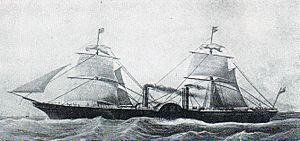RMS Persia facts for kids

Cunard's Persia of 1856
|
|
Quick facts for kids History |
|
|---|---|
| Name | Persia |
| Namesake | Persia |
| Owner | Cunard Line |
| Route | Atlantic crossing. |
| Builder | Robert Napier and Sons, Glasgow |
| Launched | 25 July 1855 |
| Maiden voyage | 26 January 1856 |
| Fate | Taken out of service 1868, scrapped 1872 |
| General characteristics | |
| Type | Steamship |
| Tonnage | 3300 grt |
| Length | 398 ft (121 m) |
| Beam | 45 ft (14 m) |
| Installed power | 1 × 2-cylinder side-lever steam engine with 100 inch bore and 10 ft stroke |
| Sail plan | 2 masts |
The Persia was a famous British passenger liner that sailed across the Atlantic Ocean. She was built by the Cunard Line and became very well-known in 1856. That year, she won the Blue Riband award for being the fastest ship to travel from Europe to America.
Persia was special because she was the first ship to break an Atlantic speed record that was made of iron. When she was launched, she was also the biggest ship in the world! However, the way she was powered, using large paddle wheels, became old-fashioned quite quickly. Because of this, Persia was taken out of service in 1868, after only twelve years. People tried to change her so she could use sails, but it didn't work out. In 1872, this once-proud ship was taken apart for scrap.
Contents
Building a Record Breaker
In the 1850s, the Cunard Line wanted to be the fastest shipping company on the Atlantic. They faced tough competition from another company called the Collins Line. To get back their speed records, Cunard first ordered a ship named Arabia in 1852.
Arabia had powerful engines packed into a smaller ship. She could reach speeds of 15 knots (about 28 km/h) during her tests. But her wooden body wasn't strong enough for such powerful engines, so she couldn't win the records. This taught Cunard an important lesson: future ships needed to be built with strong iron hulls.
Designing the Persia
For the Persia, the company Robert Napier and Sons in Glasgow designed a ship made of iron. This new ship was much bigger than the Collins Line's wooden ships. It was also 50% larger than Cunard's own Arabia.
Persia's engine was a huge two-cylinder side-lever engine. It produced a lot of power, but it also used a massive amount of coal every day. When Persia was launched in July 1855, it was a big national event. During her trials, she reached speeds of 17 knots (about 31 km/h). However, her usual speed was kept to 13 knots (about 24 km/h) because she used so much fuel. The ship could carry 250 first-class passengers and 50 second-class passengers.
Persia's Journeys and Challenges
On her very first trip in 1856, Persia hit an iceberg. Luckily, her strong iron build and pointed front (called a clipper bow) saved her from serious damage.
Winning the Blue Riband
In April 1856, Persia set new Atlantic speed records in both directions.
- She traveled eastbound (from America to Europe) in 9 days, 10 hours, and 22 minutes. This was an average speed of 13.46 knots (about 24.9 km/h).
- She traveled westbound (from Europe to America) in 9 days, 16 hours, and 16 minutes. This was an average speed of 13.11 knots (about 24.3 km/h).
Persia held both of these records until 1863. That's when Cunard launched the Scotia. Scotia was the last ship to hold an Atlantic speed record using paddle wheels. Scotia was originally planned to be similar to Persia. However, her building was delayed when the Collins Line went out of business. When Scotia was finally built, she was a larger version of Persia with an extra deck and more power.
Changing Times for Ships
In 1861, during a time of tension called the Trent incident, Persia and other ships were used to quickly move soldiers to Canada. Persia was the only ship that reached Quebec before ice closed the St. Lawrence River.
The next year, Cunard launched the SS China. This was a very important ship because it was Cunard's first mail ship that used a screw propulsion system instead of paddle wheels. The China proved to be much more profitable than the paddle steamers. Because of this, Cunard quickly ordered two more screw-propelled mail ships. These new ships were meant to replace the last wooden paddle steamers on the busy New York route.
Persia continued to sail the New York route alongside Scotia until 1867. That year, Cunard launched the Russia, which was the first screw-propelled Cunard ship that could match Scotia's speed. Because Persia used so much fuel, she wasn't a good fit for other routes. So, in 1868, she was put out of service. Her engines were taken out, and she was sold to a company that planned to change her to use sails. But this change never happened, and Persia was sold for scrap in 1872.



